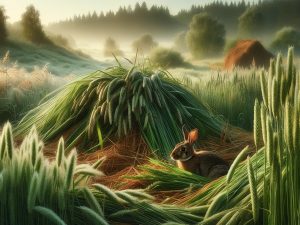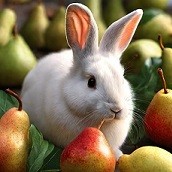Can Rabbits Have Cool Season Grass Hay? Diet & Nutritional Guide
Welcome, bunny owners and

What is Cool Season Grass Hay?
Cool season grass hay refers to hays harvested from grasses that thrive in cooler temperatures. Unlike their warm-season counterparts, these grasses – such as timothy, orchard, and brome – peak in growth during the spring and fall. These hays are often praised for their balance of fiber and nutrients.
The Bunny Buffet: Is Cool Season Hay on the Menu?
Yes, indeed! Cool season grass hays are a wonderful choice for rabbits. These hays are not just filler; they’re a cornerstone of a healthy rabbit diet, providing the essential fiber needed to keep their digestive systems running smoothly.
How Much Hay to Hay?
When it comes to hay, there’s no such thing as too much. It should make up the majority of a rabbit’s diet, available at all times. Rabbits need to munch on hay throughout the day to aid digestion and maintain dental health.
The Hay Advantage
Cool season grass hays bring a lot to the table. They are typically lower in protein and calcium than legume hays like alfalfa, which is beneficial for adult rabbits. These hays help prevent obesity, maintain dental health, and keep the gut moving.
Cool-Season Grass Hay for Small Animals
| Feature | Description | Reference |
|---|---|---|
| Nutritional Value | Cool-season grass hay typically has a crude protein content between 8-10% and provides about 2 Mcal per kg of dry matter. | 3, 5 |
| High Digestibility | Cool-season forage grasses are highly digestible, averaging about 70% for dry matter over the year. | 3 |
| Health Benefits | Cool-season grass hay provides essential nutrients like calcium and phosphorus, contributing to its easy digestibility. It is suitable for small animals like rabbits. | 4, 5 |
| Growth Pattern | Cool-season grasses grow most abundantly in spring and fall, with growth slowing in warmer summer months. | 1 |
| Potential Risks | Grass tetany, a condition caused by magnesium and calcium deficiency combined with high levels of potassium, can be a major anti-quality factor associated with cool-season grasses. | 2 |
References:
A Word to the Wise
While cool season grass hays are excellent, it’s important to ensure they are fresh and free from mold and dust, which can cause respiratory issues in rabbits. Always check the hay before giving it to your furry friend.
Variety is the Spice of Life
While cool season grass hay can and should be the bulk of your rabbit’s diet, don’t forget to round it out with fresh leafy greens, a small amount of pellets, and the occasional fruit treat for a balanced and varied diet.
So, feel confident adding cool season grass hay to your rabbit’s daily feast. It’s not only a meal but also an activity, providing endless hours of grazing fun. Keep the hay rack full, and your bunnies will thank you for their fluffy, fiber-rich meals!
Frequently Asked Questions About Cool Season Grass Hay for Rabbits
What is cool season grass hay?
Cool season grass hay comes from grasses that grow primarily during the spring and fall. It’s a favorite for rabbits due to its optimal balance of nutrients and fiber.
Can all rabbits eat cool season grass hay?
Yes, rabbits of all ages can eat cool season grass hay. It’s especially good for adult rabbits because it’s lower in protein and calcium compared to legume hays.
How much cool season grass hay should rabbits eat?
Rabbits should have constant access to cool season grass hay. It should make up the bulk of their diet to ensure proper digestion and dental health.
What are the benefits of feeding cool season grass hay to rabbits?
This type of hay helps prevent obesity, promotes dental health by grinding down teeth, and provides essential fiber for a healthy digestive system.
Are there any risks associated with cool season grass hay?
The primary risk is the potential for mold and dust, which can cause respiratory problems. Always inspect hay for freshness and cleanliness before feeding.
What should I do if my rabbit doesn’t like cool season grass hay?
Try mixing it with other hays or adding fresh
Can cool season grass hay be the only thing my rabbit eats?
While hay is the most crucial part of a rabbit’s diet, they also need a variety of







Leave a Reply